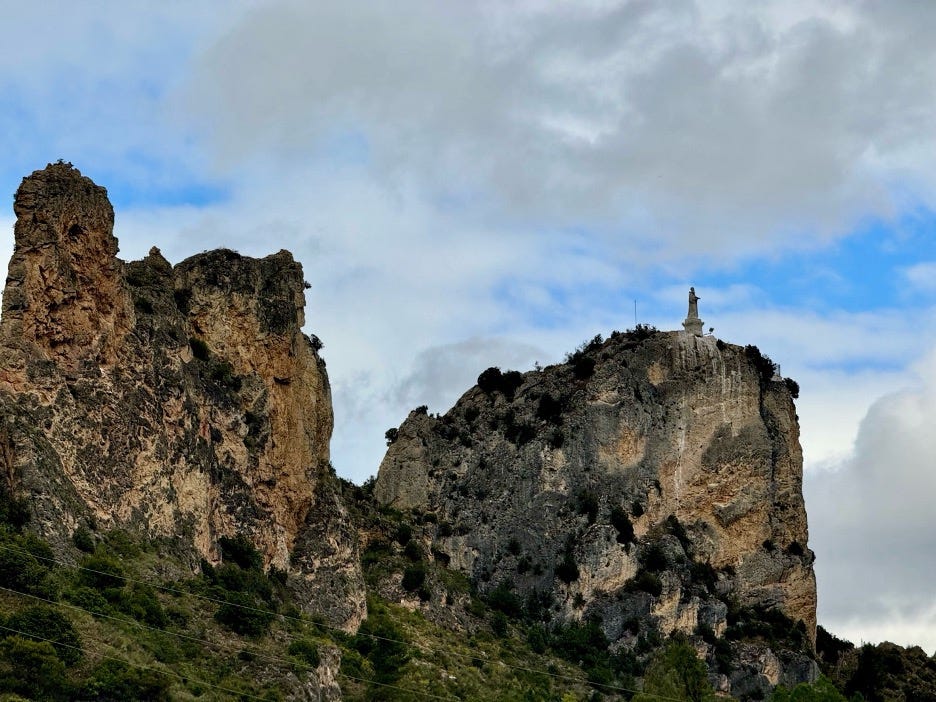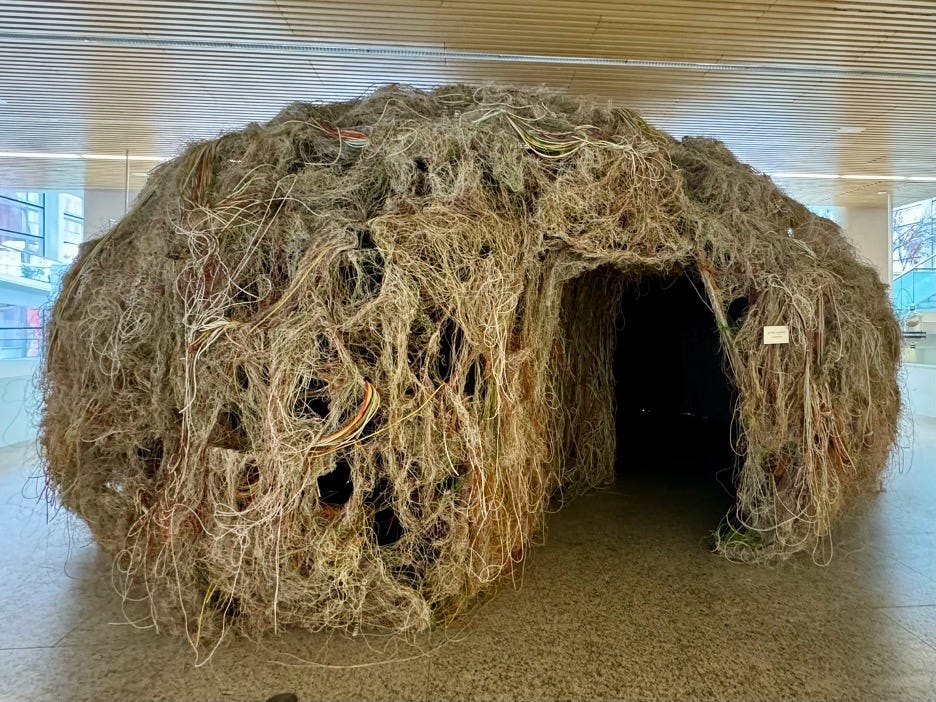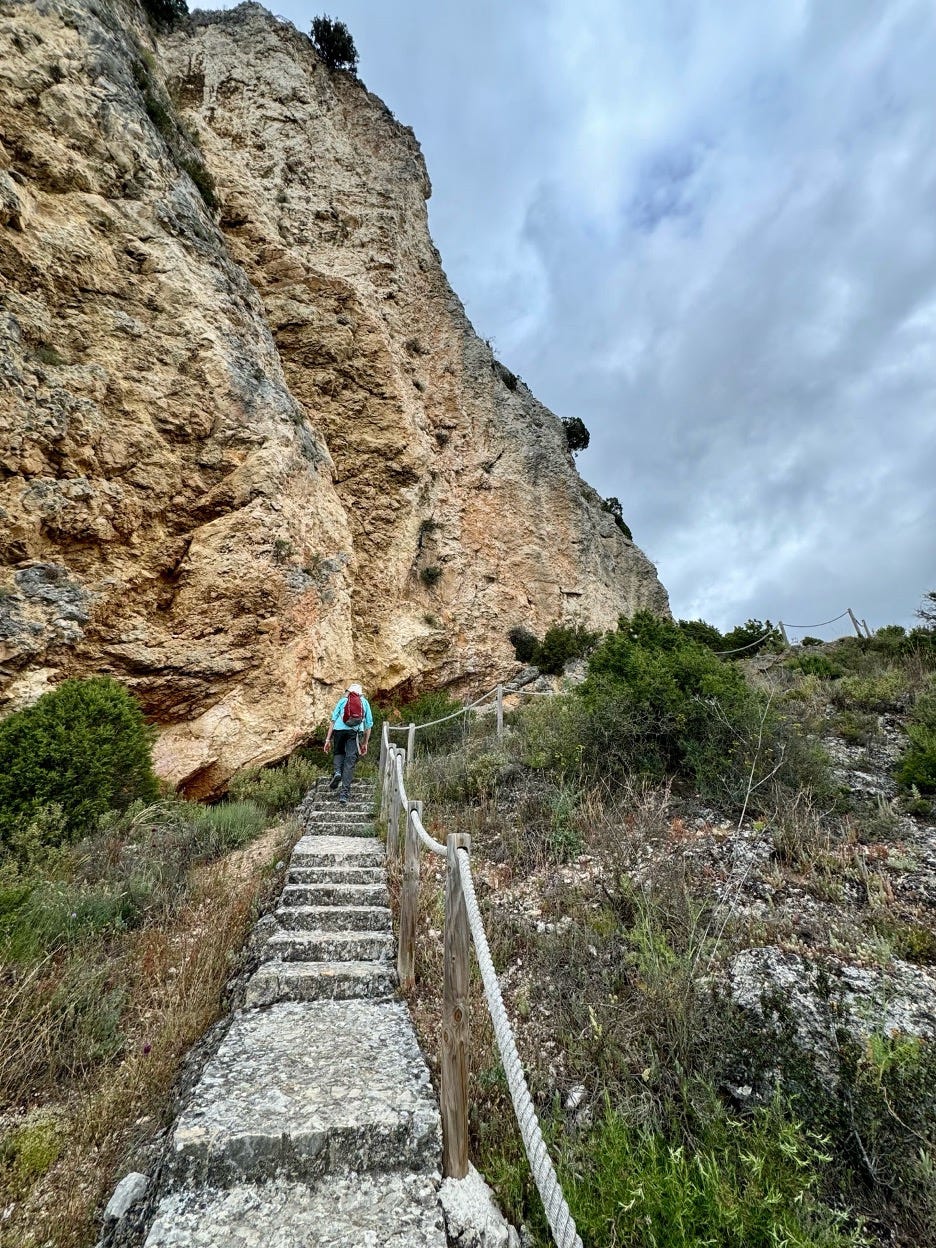Visiting Relatives
118.67 miles hiked, 6 Cultural Events Attended
Everyone knows that Spain is the capital of churches and cathedrals. In the 16th and 17th centuries, Spain was the world superpower because of its unquenchable extraction of wealth from the newly discovered continents in their named Americas. Every city, town, and village have a church that dominates the resulting skyline to a comical, and in some cases, grotesque, degree.
Something struck me at breakfast thinking about Rosalind’s wonderful tour of Burgos Cathedral yesterday. While she talked about the art, especially the Flemish influence on Spain, much of the tour talked about chapels, and in some cases, cathedrals, on the sides and behind the altar of the main cathedral. These all have names like Chapel of Saint Henry, Chapel of Saint Anne or of the Conception, or Chapel of the Constable, which seem and sound like they are dedicated to the individual saints. The subversive part of Rosalind’s tour was that she concentrated on the individual(s) buried in the middle of each of these chapels.
The picture above is the overly rich guy (it’s always a guy), who paid for the initial refurbishment and construction of the Burgos Cathedral we see today. I can’t remember the name of this person, and, honestly, it’s not worth knowing. This dude’s “chapel” off the main part of the church is extravagant beyond belief with altars and pulpits so Mass must be performed in perpetuity with the mortal remains of whoever this is at the center of everything, so anyone attending Mass must pray for the soul of Mr. Rich Dude. You can see from the headgear, this isn’t a priest, cannon, or bishop. This is just a billionaire of the day who feels they deserve being the center of attention forever, solely because they are rich. Most of the other chapels were paid for by members of the clergy, who are supposed to serve the poor, but somehow they have far more money than Croesus.
The iconography of the time was all about showing the “piousness and goodliness” of these stupidly rich people. They are prudent, wise, and didn’t succumb to the seven deadly sins. While an atheist, I had to laugh because the seven deadly sins are quite clear. Lust: the desire for money or power. Gluttony: overconsumption of anything to the point of waste. Greed: duh! Envy: how dare they have a better chapel than me. Pride: hubris in bucket loads. Pride: in spades. Wrath is a little harder to pinpoint, but the anger to make my chapel more glorious than yours is worth at least half a point. I will concede that these people did not have Sloth. Final tally: 5.5 of the seven deadly sins are permanently on display in these chapels. No worries, these hypocrites thought, I have so much money that I’ll buy enough indulgences that it doesn’t matter, and I shall be quickly led to heaven with choirs singing, because I bought a first-class ticket.
The sign of a great guide is that they make you think and wonder. Rosalind did that because I’m still processing her tour the next day and will be for a while. If you ever visit Burgos, let me know and I’ll give you her contact information. You will learn a great deal and she’ll force you to think about things in a different way. Kudos to Rosalind!
When I explained my theories about Rosalind’s tour to Pam at breakfast, she summed all the profligate displays in Burgos Cathedral or any small town in Spain better than I could in 500 words: my tiny peepee is bigger than your tiny peepee. As always, if you don’t like these ideas, unsubscribe at any time. I respect your decision to do so.
After breakfast, we had to make a pilgrimage to an honest to god holy place. A place that explains your place in the word. A place that puts true meaning into your soul. In my opinion, the most holy of holy places in Spain: The Museum of Human Evolution.
Ten kilometers north east of Burgos is Atapuerca, a cave system where archeologists discovered the earliest remains of hominids from 1.2 million years ago. This is the oldest know site in Europe for these remains. The museum is the story of those remains and how they, and us, fit into the genus of Homo in Europe. We absolutely loved the museum and demand you put it on your bucket list of places to visit. 😺 If you have any European ancestry, it’s only respectful that you visit your elders! These are your relatives after all.
Level -1 shows you all the amazing discoveries at Atapuerca and how the site came to be. As you move up to Floor 0 shows the work archeologists do and how intense it is. On this floor they show the evolution fromAustralopithecus afarensis (AKA “Lucy”), to Homo rhodesiensis, to us Homo sapiens. We both thought that this display was astounding.
At the end of the above family tree display was a discussion of the Homo sapiens most potent advantage: our brains. It ended in one of the best pieces of art we’ve seen in ages.
The outside is a myriad of computer network cabling standing in for the connections your synapse makes across the brain. When you walk in, you hear recordings of the pops and clicks for the electrical signals firing across them. It’s dark and the artist used light to show those connections.
I couldn’t find who the artist was, but it was all I could to not fall to my knees in awe at such an inspired interpretation of this 3.3-pound machine that requires 20% of our oxygen intake, but only is 2.2% of our weight. To see the most complicated machine ever created in the universe in a completely new way was more moving and meaningful than any rich jerk’s “look at me” chapel. The worship of science is my religion and this entire museum its holy place. Only 0.4 miles separates the Burgos Cathedral from the Human Evolution Museum, but there’s only one cathedral in Burgos, and it’s absolutely not the one with the name.
We had taken many hours in the museum and only looked at half of it. Given all the time in the car and lack of hiking the last few days, (our reason for traveling!) we asked the Human Evolution Museum its blessing to let us move on with the promise we’ll come back and complete the half we didn’t see in this visit. I so wish I could bring all of you wonderful people to see the museum.
After a quick stop for tapas, and more mochillo (pig blood sausage) for me, I look up a hike we can do in the time we have left. Given the hell of getting into the city yesterday, we weren’t sure how it was going to be getting out of the city. If getting into the old town was Dante’s 931st level of hell, getting out was better at Dante’s 795th level. None of the GPS apps could give us a route. At one point, I had to back up down a single car wide street the length of Manhattan (at least that’s what it seemed to me!). Lesson learned: unless you are native born, never, ever drive in a Spanish city center.
In the silence of frustration, we drive an hour to the trail head not knowing what to expect at all on this randomly chosen hike in the minuscule town of Villalba de Rioja. Less than a quarter mile from the car, we meet the town greeter Otto (from his collar). He’s the goodest of boys
Twenty steps later, we see a pilgrim, so start feeling a little better. This trail isn’t on a Camino, but who cares with something this fun.
While it’s nice to be out walking, since we haven’t done much the last few days, we come upon a huge stone wall seemingly out in the middle of nowhere. Following it up, we find it’s the walls to Santa Mariá de Herrera, a monastery of the Camaldolese, which is a monastic order of Pontifical Right for men founded by Saint Romuald. We are not sure what all that means, but at the gate it says visiting hours are this afternoon from 3:00-5:00 and it’s 4:30. We don’t hear anything inside but there’s a sign that says ring the bell. I’m worried that we’ll bother them, but Pam is braver than I am and give it a pull. Nothing happens. I then see a sign that talks in Spanish about the cost of visiting and we have no cash on us. I’m sure they don’t take credit cards. With cell signal, we look them up on the web and their blog hasn’t been updated in a few years. Based on the complete silence inside, I’m pretty sure it’s abandoned at this point.
A little bit down the hill from the monastery is a cave so we have a look. It’s a man-made cave and must have been a wine or storage cellar for the monastery.
Twenty minutes past the cave, we come to an abandoned salinas, a salt mine. This area has salt deposits underground that have streams flowing through them, so they harvested the salt back in the old days. It wasn’t much to see, but we thought it was pretty cool to see the placard that explained how it worked.
We are at the point where the hike is grinding along because we are a little concerned about the time and we are also walking next to a major road. It’s uphill of course. Across the highway, we can see a dramatic looking peak with a church building and a huge statue on top. The day is very overcast and it’s far away, so the pictures aren’t worth it.
The trail intersects a bridge across the highway for walkers and bikers and we decide to walk over to see what’s on this prominent point. Keep in mind that we picked this hike based on length and elevation gain simply to get in a hike after all the frustration of driving the last few days, especially the hell of Burgos. We know nothing about the hike or the area.
Across the bridge is a completely out of proportion picnic area. It’s weirdly huge, which means there’s something about this church high up on the narrow peak that has a big festival associated with it. We also see a side peak that has a hole in it about halfway down the hill. There are no signs telling us what we are looking at, but we need a break as we are very tired. That’s when it hits us that we’ve been standing up for four hours in the morning and have just done six miles of ups and downs without a rest. That was stupid of us, but the desire to walk outweighed common sense.
We discuss what we want to do. Above us is a sign that says the ramp up is 90% difficult and the stairs up to the top is 30% difficult. It’s hard to tell how much up we are talking about. Since I’m a weirdo, I tell Pam that I’m 51% in favor of going up. She’s not too sure, but has that feeling that if I go up, she will too. I tell her to stay at the picnic area and rest, but I think I’ll give it a try. Since the ramp is loose rock, and 90% difficult, I’ll go up the stairs. I encourage Pam to stay but she is afraid of missing out.
After much girding of the loins, we start up the stairs with Pam saying that she might turn back if it’s too tough. I tell her, I’ll follow her lead. We head up and immediately feel like complete morons. We are at the top in 10 minutes! We totally overestimated what we were dealing with! 😹😹 We just had to laugh.
This church at the top is dedicate to one of the patron saints of La Rioja town of Haro, San Juan, who always overlooks the town. The views are incredible.

We finished the walk with joyful hearts because we had such surprises on it. I’ll talk more about the place we are staying tomorrow. Let this be a lesson, if it says 30% difficulty, you can do it!
Thanks for reading! (A bonus picture for reading this far)











Great views and poppies, but the brain was awesome!!!
From little peepees to poppies and every mind blowing adventure in between! Loved the views today and always like flower pictures.